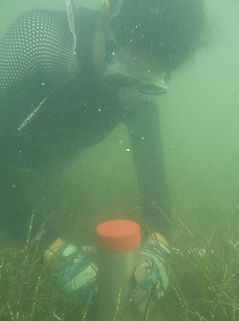
In U.S. Atlantic salt marshes, the purple marsh crab, Sesarma reticulatum, creates fronts as it consumes the smooth cordgrass, Spartina alterniflora. Sesarma fronts form at the heads of tidal creeks and move directionally inland, creating distinct zonation between the tall-form Spartina low marsh and the short-form Spartina high marsh, separated by a denuded bang of mudflat. Sesarma's direct consumption of Spartina and its burrowing activities, which resuspend previously consolidated sediments and organic matter, pose a threat to the resilience of salt marshes and their carbon pools. Using a combination of field-derived and remote sensing data, we are examining the effects of Sesarma fronts on saltmarsh carbon stocks and quantifying carbon fluxes as the front propagates through marshes in Georgia, South Carolina, and Virginia. (Wittyngham, Johnson, Chen, & Kirwan, in review)
Linking Ecological Interactions with Ecosystem Function and Resilience

A consumer front created by Sesarma reticulatum.
(Photo credit: Aileen Devlin | Virginia Sea Grant)

A sediment peat core collected to assess bulk density and organic matter content in sediments.
Consumer fronts and carbon storage
Carbon storage in seagrasses
Historically, the Chesapeake Bay was dominated by the seagrass species, Zostera marina. However, as climate change increased water temperatures in recent decades, Ruppia maritima has increased its spatial coverage and densities. Thanks to long-term observations (~20 years) of seagrass species presence and density, we are able to ask the question: how does carbon storage vary with species identity, meadow age, and within the estuary? Sample processing is ongoing, so stay tuned for results! (Hall, Molino, Wittyngham, Kirwan, Patrick, and Orth, in prep)

From left to right: Aly Hall, Kyra DeGroat, Serina Wittyngham, Grace Molino, and Caitlin Sughrue. (Photo credit: Aly Hall)

Grace Molino collecting an underwater sediment core. (Photo credit: Aly Hall)
Revisiting methods underlying vertical accretion and blue carbon estimates
Current estimates of both vertical accretion and carbon storage potential are based on standard loss-on-ignition techniques (iterative drying and burning of soil samples) and dry mass to volume conversions. However, these processes make several key assumptions that we have found lead to the significant underestimation of belowground tissue and overestimation of sediment organic matter contributions to sediment volume. Using machine learning models on CT-scanned salt marsh sediment cores, we are able to better estimate these component contributions. These findings not only apply to salt marsh ecosystems, but any ecosystem in which these methods are applied. (Peck & Wittyngham, in prep)

An example CT scan that is fed into a trained machine learning algorithm to identify plant roots, rhizomes, and sediment in volume percent.


